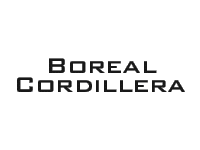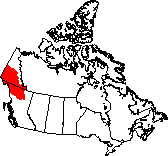|
Location
| Climate | Geology and geography
| Flora and fauna | Humans | Images
Location
This ecozone contains the mountainous southern Yukon and northern British
Columbia.
Climate
The mountains in the west of the Boreal Cordillera stop much of the
precipitation that would normally fall, so the region tends towards
dryness, with less than 300 mm of precipitation in the west. Precipitation
rises to the east, with up to 1500 mm falling on some slopes. From one
third to two-thirds of the precipitation falls as snow. Average winter
temperatures are -18ºC, while the short summer averages 10ºC.
Geology
and Geography
Mountains and plateaus are the dominant features, separated by lowlands
and valleys. Debris and deposits from glaciers cover the plateaus and
valleys, and even the lower slopes of the mountains have deposits.

Flora
and Fauna
Plants
Trees grow in the lowlands and on the lower slopes. As elevation increses,
trees become stunted and above the treeline only shrubs, moss, lichen
and herbs are found. Much of the upper slopes is bare rock, snow and
ice. Trees of the area include white
spruce, black
spruce, Engelmann spruce, alpine
fir, lodgepole
pine, whitebark
pine, trembling aspen, balsam poplar, white
birch, water
birch, scrub birch, and Bebb willow. Some of the other plants in
the ecozone are Labrador tea, mountain aven, eriacaceous shrubs, sphagnum
moss, cottongrass, and mountain
hemlock.
Animals
Mammals
Some of the large herbivores are caribou,
moose, Dall’s
sheep, mountain
goat, and bison.
Large carnivores that are found here include black
bear, grizzly
bear, lynx,
and wolf.
The smaller herbivores include hoary
marmot, woodchuck,
arctic ground
squirrel, beaver,
brown lemming,
collared lemming,
American pika,
and snowshoe
hare. Smaller carnivores such as marten,
least weasel,
river otter,
striped skunk,
mink, coyote,
muskrat,
and red fox
are found here.
Birds
Some of the characteristic birds of prey are the snowy
owl, boreal
owl, short-eared
owl, northern
goshawk, red-tailed
hawk, sharp-shinned
hawk, Swainson's
hawk, and common
nighthawk. Shorebirds and seabirds that can be found here include
common snipe,
wandering tattler,
herring gull,
mew gull, and
Bonaparte's gull.
The birds of the forest include willow
ptarmigan, rock
ptarmigan, white-tailed
ptarmigan, blue
grouse, spruce
grouse, ruffed
grouse, northern
flicker, and downy
woodpecker. Waterfowl such as northern
pintail, blue-winged
teal, mallard,
canvasback,
and Canada goose
can be found in the Boreal Cordillera. The songbirds of the area include
raven, red-winged
blackbird, purple
finch, American
dipper, rusty
blackbird, common
yellowthroat, and varied
thrush.
Amphibians and Reptiles
Although the climate here is too hostile for most amplibian and reptile
species the wood
frog can be found.
Fish
Predatory species such as the northern pike prey on species that include
lake whitefish and white chub. Several species, including white sturgeon,
pink salmon, chum salmon, coho salmon, and sockeye salmon, come inland
to spawn.
Molluscs
Three of the molluscs found here are the valve
snail, muskeg
stagnicola, and arctic-alpine
fingernail clam.
Humans
Mining has historically been economically important for this ecozone,
the Klondike gold rush being the best known incident. Most mines have
closed down recently, and forestry is becoming more important. Wherever
mines have been, their toxic tailings and environmental damage have
long-lasting effects.
Images
Kluane
Lake, Yukon
Kluane
Lake, Yukon
Kluane
Lake, Yukon
Kluane
Lake, Yukon
Sheep
Mountain, Kluane National Park, Yukon
Sheep
Mountain, Kluane National Park, Yukon
Kaskawulsh
Glacier, Kluane National Park, Yukon
Marsh
near Kluane National Park, Yukon
Alpine
valley, central Yukon
Alpine
valley, central Yukon
Mountains
in Yukon
Glacier,
Yukon
Snag
Lake, Yukon
View
from Keno Mountain, Yukon
Small
stream near Whitehorse, Yukon
Spruce
forest near Whitehorse, Yukon
Yukon
River, near Whitehorse, Yukon
Regrowth
on old gold diggings, Dawson City, Yukon
Falls
in White Pass, British Columbia
Near
White Pass, British Columbia
Mount
Fairweather, British Columbia's highest peak
Stone
Mountain Provincial Park, British Columbia
Near
Cassiar Highway, British Columbia
Chilkat
Pass, British Columbia
Warm
Stream, Atlin, British Columbia
 

|
|







